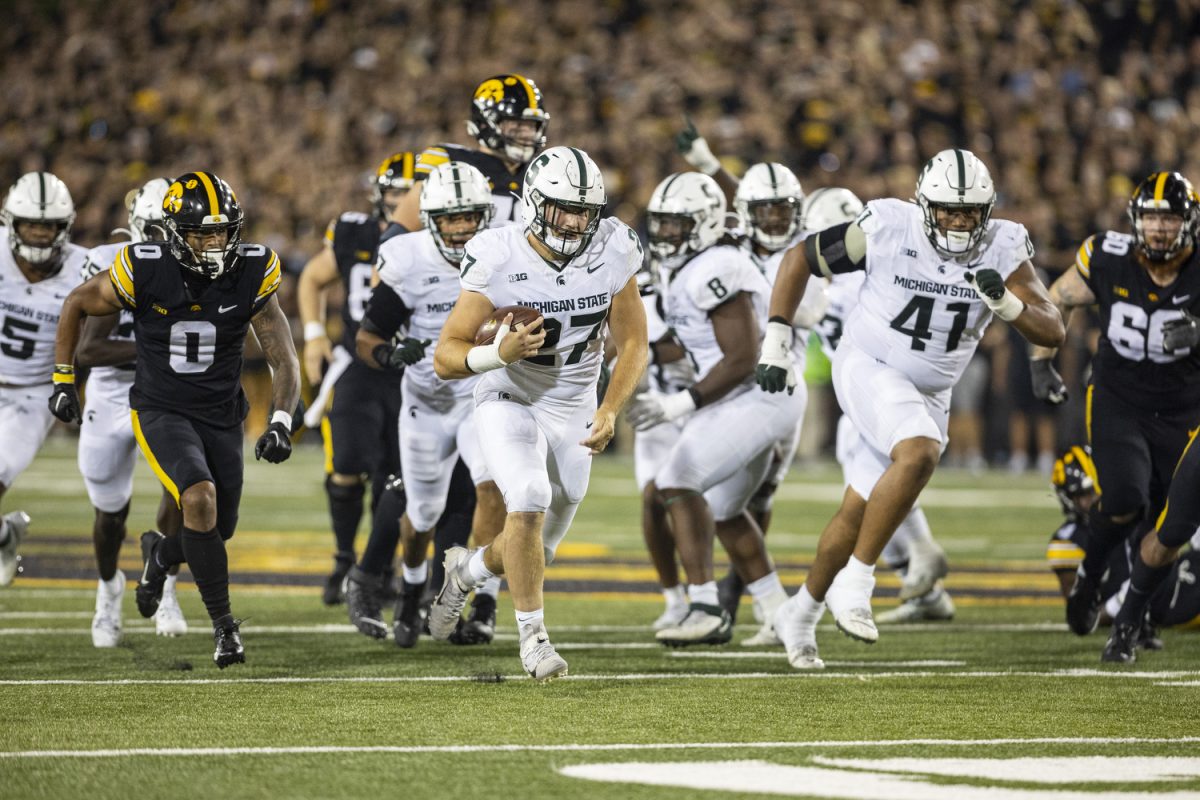1. Containing Aidan Chiles
Michigan State made an early splash in the transfer portal, landing Oregon State quarterback Aidan Chiles in December. A four-star transfer and the second-ranked at his position according to 247 Sports, Chiles arrived in East Lansing with 309 passing yards under his belt after seeing scattered reps for the Beavers last season.
In 2024, the 6-foot-4 Chiles isn’t afraid to throw the ball downfield, averaging eight yards per completion on 1,212 passing yards, but the 19-year-old is more than comfortable on the run. The second-year has the most rushing yards for any Big Ten quarterback with 115 on 25 carries and running for three scores. Iowa’s defense will have to keep Chiles in the pocket and prevent him from making plays with his legs.
Iowa head coach Kirk Ferentz said Chiles left a lasting first impression when he saw him on film in the Spartans’ game against Ohio State. A dangerous player who can inflict wounds both on the ground and in the air.
“You have to stick with your position, stick with your responsibilities,” Ferentz said of defending Chiles. “If you’re in the back end especially, you can’t be coming out of coverage because [Chiles] looks like he’s pulling [the ball] down.”
2. Red zone production
While Iowa changed up its red zone offense three weeks into the season by inserting backup quarterback Brendan Sullivan, the Hawkeyes still haven’t been perfect inside the 10-yard line. For instance, in Week 7 against Washington, the Hawkeyes went from one yard away from paydirt to settling for a 25-yard field goal as Sullivan was sacked and nearly fumbled on the play, as he attempted a head-scratching backward pass while being tackled.
Michigan State will be a challenge, as the Spartans are tied for 13th in the FBS with a 70 percent opponent conversion percentage in the red zone. Senior linebacker Jordan Turner and defensive lineman Khris Bogle each have three sacks to lead the defense. The Hawkeye offensive line – with new starter Tyler Elsbury in at left guard – will have to be at its best near the end zone to ensure points on the board for the road team.
3. Receiving corps depth
With wide receiver Kaleb Brown in the transfer portal, Iowa wideout Dayton Howard took his spot on the depth chart and made an instant impact against Washington, scoring a 33-yard touchdown on his first collegiate catch. The 6-foot-4 Howard has height, which will serve as an advantage for contested catches.
While not on the depth chart for this week, third-year receiver Seth Anderson also figures to get some reps on Saturday after making his first catch of the season against the Huskies. Anderson, a transfer from Charleston Southern, recorded a catch or carry in ten of Iowa’s games last season before missing the first four games of 2024 with a hamstring injury.
“I’m a competitive guy,” Anderson said. “I feel like I’ve got some speed to me. I feel like I can go up and get the ball and things like that, so I’m just trying to figure out where I fit in this offense and how I can make plays for the team.”
With tight end Addison Ostrenga on the sidelines for the second week in a row, these two receivers will likely play another key role on Saturday.
4. Turnover battle
After forcing multiple turnovers in three consecutive games, the Hawkeye defense has a golden opportunity before it on Saturday. For all of Chiles’ talent, the quarterback is still inexperienced and is prone to interceptions. His eight picks rank second in the Big Ten. In addition to six lost fumbles, the Spartans have 14, ranking 126th in the FBS. Plus, their defense hasn’t made these miscues negligible, as Michigan State sits in 118th place in turnover margin.
Meanwhile, Iowa has been well-adept at keeping the ball in its hands, yielding only five turnovers this season. Winning any game in enemy territory requires triumphing in the turnover battle, and the Hawkeyes will have the advantage in East Lansing.
5. No negative plays
What kills an offense in any environment is negative plays, and Michigan State enjoys creating them with its defense. The Spartans rank 39th in the FBS with 39 tackles for loss this season whereas the Hawkeyes languish in 120th with 25. Iowa offensive coordinator Tim Lester hasn’t opted for many screen passes this season, but the Hawkeyes can’t get caught in the backfield.
Kaleb Johnson is no stranger to shedding tackles, but Iowa’s other running backs can’t get caught flat-footed in the backfield. A large part of Iowa’s success on third down has been that the Hawkeyes have been getting into manageable yardage situations. Any negative plays put the team in third-and-longs, essentially forcing the Hawkeyes to pass and not rely on play-action.



